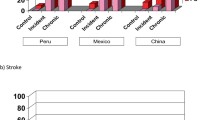Abstract
Myanmar is one of the poorest and least healthy countries in Southeast Asia. As elsewhere in the region, population aging is occurring. Yet the government welfare and health systems have done little to address the long-term care (LTC) needs of the increasing number of older persons thus leaving families to cope on their own. Our study, based on the 2012 Myanmar Aging Survey, documents the LTC needs of persons aged 60 and older and how they are met within the context of the family. Nearly 40% of persons in their early 60s and 90% of those 80 and older reported at least one physical difficulty. Spouses and children constitute the mainstay of the financial and instrumental support of elderly including those with LTC needs. Nearly two-thirds of older persons reported receiving assistance with daily living activities. More than three quarters coreside with children, a living arrangement that in turn is strongly associated with receiving regular assistance in daily living. Daughters represent almost half and spouses, primarily wives, one-fourth of primary caregivers. Unmet need for care as well as inadequate care decline almost linearly with increased household wealth. Thus elderly in the poorest households are most likely to experience gaps in LTC. Given mounting concerns regarding health disparities among Myanmar’s population, this pattern of inequality clearly needs to be recognized and addressed. This needs attention now rather than later given that reduced family size and increased migration pose additional challenges for family caregiving of frail elderly in the coming decades.

Similar content being viewed by others
Notes
Unfortunately, the survey does not contain detailed information about each care provider, thus not allowing us to precisely establish the relationship between primary and secondary caregivers.
References
Croll, E. (2006). The intergenerational contract in the changing Asian family. Oxford Development Studies, 34(4), 473–491.
Department of Population. (2014). The population and housing census of Myanmar, 2014: summary of the provisional results. Yangon: UNFPA and Ministry of Population and Immigration.
Grundy, J., Annear, P., Ahmed, S., & Biggs, B. A. (2014). Adapting to social and political transitions–the influence of history on health policy formation in the republic of the Union of Myanmar (Burma). Social Science & Medicine, 107, 179–188.
International Monetary Fund (IMF) (2015). World Economic Outlook Database October 2015. Retrieved February 12, 2016 from https://www.imf.org/external/pubs/ft/weo/2015/02/weodata/index.aspx.
Knodel, J. (2014). The situation of older persons in Myanmar: results from the 2012 survey of older persons (revised 2014). Yangon: HelpAge international.
Knodel, J., & Nguyen, M. D. (2015). Grandparents and grandchildren: care and support in Myanmar, Thailand, and Vietnam. Ageing and Society, 35(9), 1960–1988.
Knodel, J., Chayovan, N., & Siriboon, S. (1992). The familial support system of Thai elderly: an overview. Asia-Pacific Population Journal, 7, 105–106.
Knodel, J., Kespichayawattana, J., Wivatwanich, S., & Saengtienchai, C. (2013). The future of family support for Thai elderly: views of the populace. Journal of Population and Social Studies, 21(2), 110–132.
Knodel, J., Teerawichitchainan, B., Prachuabmoh, V., & Pothisiri, W. (2015). The situation of Thailand’s older population: an update based on the 2014 survey of older persons in Thailand. Chiang Mai: HelpAge International East Asia/Pacific Regional Office.
Ministry of Social Welfare, Relief, and Resettlement. (2015). Implementing Myanmar’s social protection strategic plan: proposed flagship programmes. Myanmar: Ministry of Social Welfare, Relief, and Resettlement (MSWRR).
Myanmar Survey Research. (2012). Survey on ageing in multiple regions 2012: technical report. Yangon: HelpAge International.
Population Reference Bureau (PRB). (2015). World population data sheet 2015. Washington, DC: PRB.
Risso-Gill, I., McKee, M., Coker, R., Piot, P., & Legido-Quigley, H. (2014). Health system strengthening in Myanmar during political reforms: Perspectives from international agencies. Health Policy and Planning, 29(4), 466–474.
Saw, Y. M., Win, K. L., Shiao, L. W. S., Thandar, M. M., Amiya, R. M., Shibanuma, A., Tun, S., & Jimba, M. (2013). Taking stock of Myanmar’s progress toward the health-related millennium development goals: current roadblocks, paths ahead. International Journal of Equity in Health, 12, 78 Retrieved form http://www.biomedcentral.com/content/pdf/1475-9276-12-78.pdf.
Teerawichitchainan, B., & Knodel, J. (2015). Economic status and old-age health in poverty-stricken Myanmar. Journal of Aging and Health, 27(8), 1462–1484.
Teerawichitchainan, B., Pothisiri, W., & Giang, T. L. (2015). How do living arrangements and intergenerational support matter for psychological health of elderly parents? Evidence from Myanmar, Vietnam, and Thailand. Social Science & Medicine, 136-137, 106–116.
The Lancet. (2012). Burma: Health and transition. The Lancet, 379, 2313.
United Nations, Department of Economic and Social Affairs, Population Division (2015). World population prospects: The 2015 revision, custom data acquired via website.
Women, Men and Families in Myanmar (2016). Retrieved from http://factsanddetails.com/southeast-asia/Myanmar/sub5_5c/entry-3042.html.
World Bank. (2016). Live long and prosper: ageing in East Asia and Pacific. Washington DC: World Bank.
World Bank Myanmar. (2016a). A country on the move. Yangon: World Bank Myanmar.
World Bank Myanmar. (2016b). Livelihoods and social change in rural Myanmar. Yangon: World Bank Myanmar.
World Health Organization. (2011). Noncommunicable disease risk factor survey: Myanmar 2009. New Delhi: World Health Organization Regional Office for South-East Asia.
Zaw, K. K., Latt, T. S., Aung, P. P., Thwin, T. G., & Myint, T. K. (2011). Prevalence of hypertension and its associated factors in the adult population in Yangon division, Myanmar. Asia-Pacific Journal of Public Health, 23(4), 496–506.
Author information
Authors and Affiliations
Corresponding author
Rights and permissions
About this article
Cite this article
Teerawichitchainan, B., Knodel, J. Long-Term Care Needs in the Context of Poverty and Population Aging: the Case of Older Persons in Myanmar. J Cross Cult Gerontol 33, 143–162 (2018). https://doi.org/10.1007/s10823-017-9336-2
Published:
Issue Date:
DOI: https://doi.org/10.1007/s10823-017-9336-2




